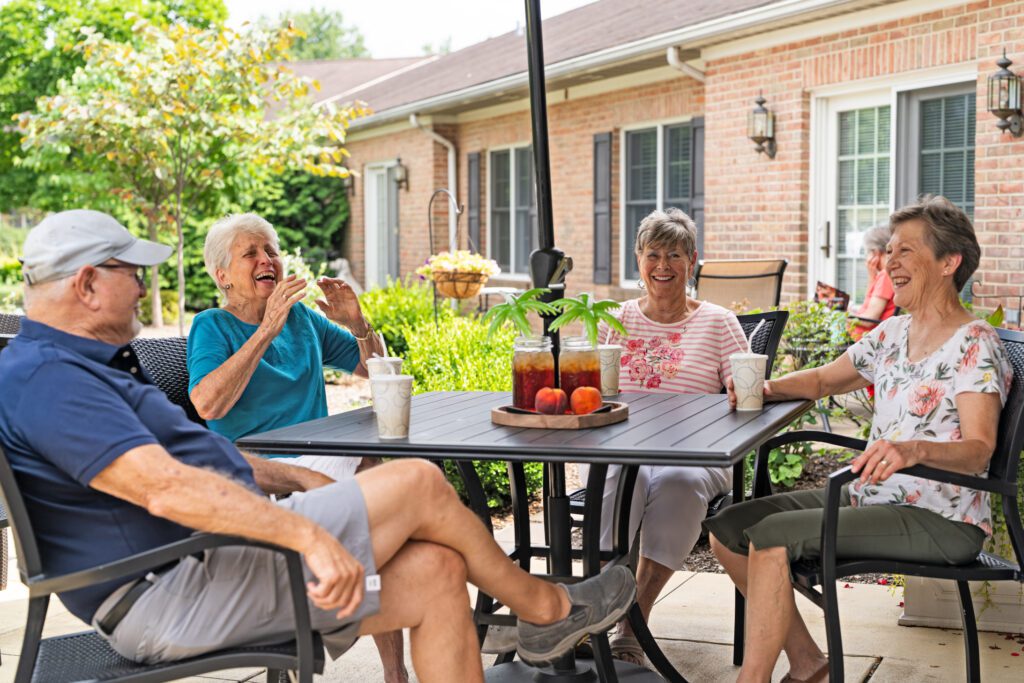Deciding on the best senior living community for yourself or a loved one can be a complex decision. Two options you’ll need to decide between are independent living and assisted living. While both options provide unique benefits, understanding the differences can help you make an informed choice.
As a Life Plan Community (also known as a Continuing Care Retirement Community or CCRC), Living Branches offers communities at the independent and assisted living levels – for today’s and tomorrow’s needs.
Table of Contents:

What is Independent Living?
Independent living is active, self-sufficient seniors who can live safely in their own residence in the main campus center or a nearby cottage or villa. They do not need help with daily activities such as grooming, dressing, or taking medication.
Independent living is ideal for seniors who:
- Manage their daily routines without support other than routine outpatient care
- Want a more manageable home size with little upkeep
- Enjoy access to gyms, restaurants, recreational facilities, classes, clubs, social events, and other amenities
Amenities and Support in Independent Living
Independent living communities offer many amenities. At Living Branches, these include:
- Spacious villas, cottages, and apartments with a variety of floor plans
- Maintenance and groundskeeping included
- Dining options ranging from cozy cafes to upscale eateries
- Fitness centers, swimming pools, recreational clubs, and wellness programs
- Social, cultural, and educational events
- Trips and outings to local and regional destinations
In independent living, residents do not need 24/7 medical care and support. However, if the community is part of a larger Life Plan Community, this care is offered elsewhere on campus. If needs change over time, transitioning to a higher level of care, such as assisted living, is seamless.

What is Assisted Living?
Assisted living is designed for seniors looking to balance independence and support. In assisted living (often called personal care in Pennsylvania), residents receive care tailored to their needs.
Assisted living is suitable for seniors who:
- Want to maintain as much independence as possible but need a little help in areas like meal preparation, housekeeping, or laundry
- May need help with daily activities like bathing, dressing, or taking medication
- Benefit from regular check-ins from caregivers
- May experience mild cognitive impairment but don’t need the intensive care of a memory support unit
Amenities and Support in Assisted Living
Assisted living blends housing, personal care, and health services in a residential setting. Key features include:
- Private or semi-private apartments with housekeeping and laundry services
- Three daily meals served in a dining room, and plenty of snacks
- Help with activities of daily life (ADLs) by trained staff, available 24/7
- Medication management and regular health assessments
- Social, recreational, and wellness programs designed to promote engagement and mental stimulation
- Emergency call systems and 24-hour security for safety
Within a Life Plan Community, the transition from independent living to assisted living is smooth. The goal is to ensure continuity of care and decrease disruption.

How to Choose Between Independent Living and Assisted Living
Determining the right level of care involves evaluating several factors. Here are some considerations to help guide your decision:
Social and Lifestyle Preferences
Independent living is ideal for an active social life with minimal assistance. On the other hand, assisted living caters to those who need more support and social engagement.
Think about your loved one’s day-to-day routines and social interactions when considering independent vs. assisted living.
1. Friends and family
Is your loved one often alone, or do they spend time with friends, family, and neighbors?
2. Support system
Does your loved one receive help when they need it? Have they neglected home upkeep, self-care, or other important aspects of life because nobody was nearby to help?
3. Engagement
Does your loved one take part in social or recreational activities several times a week? Would they enjoy trying new things, taking classes, making new friends, and staying active? Independent and assisted living both offer plenty of ways to stay engaged. Generally, activities in independent living communities require a higher level of fitness and mobility than assisted living.
Desired Level of Independence
Consider your loved one’s ability to perform activities of daily living (ADLs). These are basic self-care tasks that include bathing, dressing, grooming, and using the bathroom.
Beyond these basic needs, consider whether assisted living could take more complex tasks off your loved one’s plate:
- Taking the medications at the right time and dosage
- Shopping for groceries, preparing meals, and storing food safely
- Maintaining a clean and safe living space
- Driving or arranging transportation
- Purchasing household supplies and other necessities
Assisted living offers help as needed with these tasks and many others. Caregivers, drivers, chefs, housekeepers, and other team members are here to help residents live their healthiest lives.
In independent living, many of these responsibilities fall to the resident, although their community may offer help with certain tasks.
Health Needs
Think about your loved one’s current health conditions and the potential need for medical care in the near future. Consider their:
- Chronic health conditions like diabetes, heart disease, arthritis, and more
- Cognitive capabilities like memory and decision-making
- Recent illnesses or surgeries
- Previous falls
- Risk factors for a fall, including stairs, clutter, or poor balance
- Ability to manage illnesses, such as pneumonia or urinary tract infections
- Ability to keep up with vaccinations and other preventative care
If none of these issues apply, independent living may be ideal. But for those whose health needs make it hard to live alone, assisted living may provide the perfect balance of care and independence.
Safety Concerns
Mobility issues, cognitive decline, and health issues weigh on many loved ones when deciding between independent and assisted living. If any of these risks are a concern, your loved one may fare better in assisted living than independent living.
1. Falls
A previous fall increases the risk of a future one. Even if your loved one has never had a fall, they can still be at high risk due to:
- Hazards in their home, like stairs or clutter
- Certain medications
- Certain chronic conditions
- Impaired vision
- Poor nutrition
- Waning coordination and strength
Assisted living offers the assurance of regular safety checks, fall prevention measures, and prompt response in any medical emergency.
2. Medication errors
Missed or incorrect dosages can seriously impact your loved one’s health. In assisted living communities, medication management is an option for residents who need it.
3. Ability to respond to an emergency
Living alone requires an immediate response when an alarm sounds, the power goes out, or you smell smoke. And a medical emergency can be dangerous or fatal for someone who lives alone. In assisted living, residents are cared for by teams who can help in any crisis.
As a Life Plan Community, Living Branches offers all levels of care across our campuses in Hatfield, Souderton, and Lansdale. Contact one of our sales counselors to learn which community is best for you.

